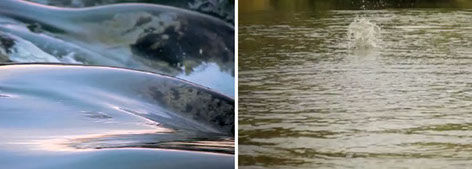SciGen Teacher Dashboard
Unit E4
Making Waves
Interactive: A Wave with Words
Duration: Approximately 55 minutes
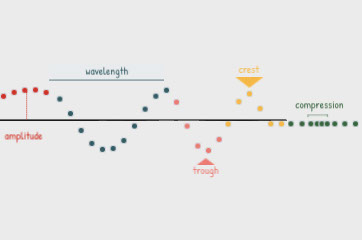 In this activity, students examine the difference between flowing water and wave motion, something noticed by Leonardo da Vinci, and they learn the vocabulary used in studying and describing waves. They consider what happens to the particles of the medium once the energy has flowed.
In this activity, students examine the difference between flowing water and wave motion, something noticed by Leonardo da Vinci, and they learn the vocabulary used in studying and describing waves. They consider what happens to the particles of the medium once the energy has flowed.
LEARNING OBJECTIVES
Students are introduced to the Focus Words, scientific language used throughout this unit.
Students practice using this important vocabulary and scientific terminology.
Teacher Tips
- The animated definitions are designed for individual exploration, but they could also be used at the front of the class with students suggesting buttons to press.
- After exploring the terms using the animated models, you can use one or two Slinky toys to play around with wave behavior and terms in the real world. Add time or an additional day if you'd like students to experiment with waves using Slinkys.
- Compression waves are not shown in the assessment image, and the term "frequency" is not shown in it either. To evaluate students' understanding of all the terms after they explore the animated definitions, you can show a compression wave in either a model (such as a Slinky) or include a drawing of a longitudinal wave in which students could label the compression.
- Students can explore the animated definitions independently or in pairs.
- You might consider showing the animations of Professor Dan Russell at the end of this session rather than in E4.3.
Materials
- optional: 1–2 long spring toys (like a Slinky)
Teacher Tune-ups
Teaching Notes
ACTIVITY OVERVIEW
- Discuss what a wave is (15 minutes)
- Explore the terms in animated definitions (30 minutes)
- Review the terms (10 minutes)
Discuss what a wave is (15 minutes)
Show the slide with the videos. Ask:
Only one of the videos is a good example of waves.
Which one? Why?
Paraphrase:
Always curious about the natural world, the 16th-century artist and inventor Leonardo da Vinci noticed the difference between flow and wave motion in water. While watching circular ripples in a pond, he observed that water particles do not flow away from the disturbance that caused the ripples, but rather, they just move up and down as the energy is transmitted through the water. Leonardo tossed small pieces of straw onto the pond to make it easier for him to observe the movement of the water.
Emphasize the difference between flowing water (the first video on the left), and water as a medium for waves to travel through (shown in the second video on the right). In waves, the water particles return to their original position after disturbance has passed.
Paraphrase:
The words we use when we talk about the properties of waves all have important scientific meanings, but they also have related uses in everyday language.
Display and discuss the slide with the Focus Word list and the blank diagram.
Paraphrase:
Does anyone know what these words mean?
This is a drawing of a wave. Would you be able to label the diagram?
We'll be looking at all of these terms today, and coming back to the diagram.
Explore the terms in animated definitions (30 minutes)
Paraphrase:
Today we are going to examine the words we use when we talk about the properties of waves. They all have important scientific meanings, but they also have related uses in everyday language. In this guide, you will compare the scientific usage of wave terminology with our everyday usage of the same words.
Click on each focus word to view an illustration and a definition.
Have students explore the vocabulary presented on the slides.
As students look at the animated definition for frequency, emphasize that frequency is the number of waves that pass a specific point in a specified time (for example, waves per second).
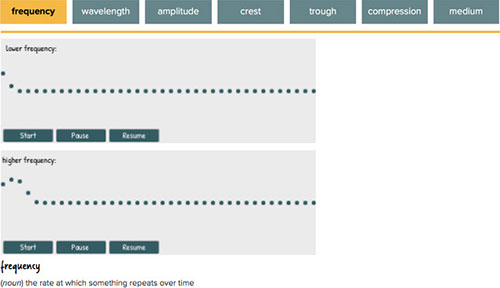


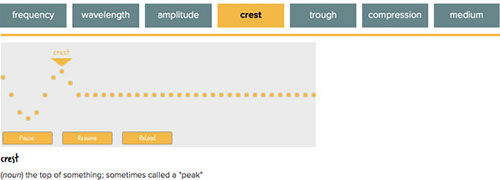
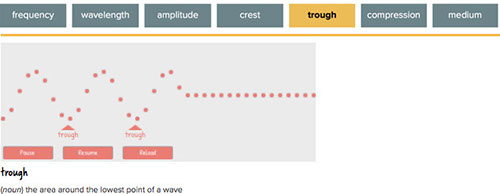
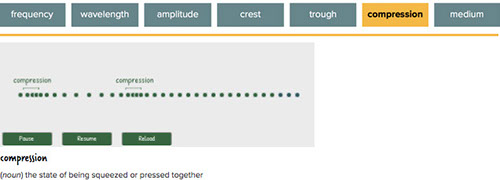
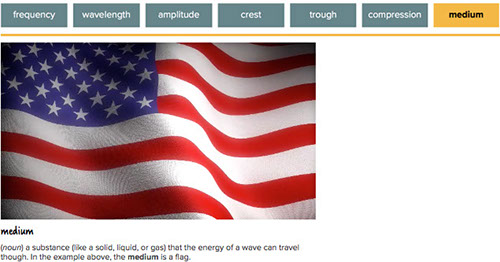
Review the terms (10 minutes)
Paraphrase:
Let's revisit the diagram we looked at at the start of class.
Display slide.
Note that the words in yellow, "frequency" and "compression," are not illustrated in the diagram.
To review the animated definitions, use the DARTS instructional strategy from Reading to Learn in Science.
Directed Activities Related to Text (DARTs) are a set of during-reading strategies designed to support reflective reading. Reflective reading (as opposed to merely receptive reading) happens when a reader breaks and re-reads challenging phrases and passages, really working at understanding. Reading with a specific purpose in mind and sharing ideas in small groups can help support reflective reading.
This "Reconstruction DART" is a cloze procedure for annotating a diagram. This format challenges students to label the wave diagram. Students predict and complete deleted labels and/or parts of diagrams using text and diagrams as sources of information.
Reconstruction DARTs are problem-solving activities that use modified text. The text has parts missing (words or phrases are deleted, or labels from a diagram). These are game-like DARTs, involving hunting for clues to complete the task. Students generally enjoy them and the results can feed into student writing about a topic.
You may want to revisit the story about Da Vinci and the videos in the prompt and talk to students about the difference between flowing water, wave motion, and what happens to the particles of the medium once the energy has flowed.
Note: a demonstration of frequency and compression could be added with the use of Slinkys. (See Teacher Tips for links.) You may also evaluate students understanding of any of the vocabulary using a slinky or rope model.
BETA Version - Please send comments and corrections to info@serpinstitute.org
